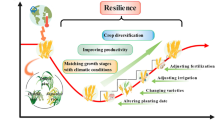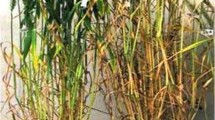Abstract
Major increases in rice production have occurred during the last 25 years, due to large-scale adoption of high-yielding semidwarf rice varieties. However, the rate of increase of rice production has slowed down, and the rate of population growth of rice consumers is now higher than the rate of increase of rice production. Severe food shortages are therefore likely to occur in 20–30 years if the trend is not reversed. To meet these food needs, rice varieties with higher yield potential are needed. The yield potential of the modern high-yielding varieties grown under the best tropical conditions is 10 t ha−1. A research program is under way to develop varieties with a yield potential of 15 t ha−1. One strategy aims to develop new rice plants with a harvest index of 0.6 (60% grain: 40% straw by weight) and with an increased ability for photosynthesis to increase total biological yield. The harvest index of the modern high-yielding varieties is 0.5. Such new varieties should have a yield potential of 12.5–13 tons ha−1. These new plant type varieties will be used to produce hybrid rices with a yield advantage of 25% over the best parent. Such hybrids would have a yield potential of 15 t ha−1.
Similar content being viewed by others
References
Ahn, J. K.: Physiological factors affecting grain filling in rice. Ph.D. thesis, University of the Philippines at Los Baños, Philippines 1986.
Akita, S.: Improving yield potential in tropical rice. pp. 41–73. In: Progress in irrigated rice research. International Rice Research Institute, PO Box 933, Manila, Philippines 1989.
Glaszmann, J. C.: Isozyme classification of Asian rice varieties. Theoretical and Applied Genetics 74: 21–30 (1987)
IFPRI — International Food Policy Research Institute: Food needs of developing countries: Projections of production and consumption to 1990. International Food Policy Research Institute, Washington, DC 1977.
Ikehashi, H.: Prospects for overcoming barriers in the utilization of indica/japonica crosses in rice breeding. Oryza 19, 69–77 (1982)
IRRI — International Rice Research Institute: IRRI towards 2000 and beyond. IRRI — International Rice Research Institute, Los Baños, Philippines 1989.
Khush, G. S.: Varietal needs for different environments and breeding strategies. pp. 68–75. In: Muralidharan, K.; Siddiq, E. A. (eds.), New Frontiers in Rice Research. Directorate of Rice Research, Hyderabad, India 1993.
Padmaja Rao, S.: High density grain among primary and secondary tillers of short-and long-duration rices. International Rice Research Newsletter 12(4), 12 (1987)
Takeda, T.: Physiological and ecological characteristics of high yielding varieties of lowland rice. In: Proceedings International Crop Science Symposium, Fukuoka, Japan 1984.
Vergara, B. S.: Raising the yield potential of rice. Philippine Technical Journal 13, 3–9 (1988)
Yoshida, S.: Physiological consequences of altering plant type and maturity. In: Proceedings of the International Rice Research Conference, International Rice Research Institute, Los Baños, Philippines 1976.
Yoshida, S.: Fundamentals of rice crop science. International Rice Research Institute, Los Baños, Philippines 1981.
Yuan, L. P.; Yang, Z. Y.; Yang, J.B.: Hybrid rice in China. Paper presented at the Second International Symposium on Hybrid Rice, IRRI, Los Baños, April 21–25, 1992 (In press)
Author information
Authors and Affiliations
Rights and permissions
About this article
Cite this article
Khush, G.S. Breaking the yield frontier of rice. GeoJournal 35, 329–332 (1995). https://doi.org/10.1007/BF00989140
Issue Date:
DOI: https://doi.org/10.1007/BF00989140




